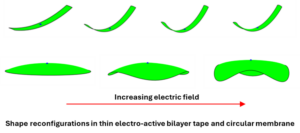Durability of polymers and composites
Our group has been combining multi-scale modeling and experiments to understand the time-dependent changes in the life performance of polymers and their composites exposed to varying mechanical loading, heat conduction, and fluid sorption. We have been formulating nonlinear viscoelastic constitutive material models for polymers accounting for heat generation from energy dissipation, micromechanical models of composites with particulate and fiber reinforcements, and governing differential equations for coupled deformation, heat conduction, and fluid diffusion. We have been collaborating with experimentalists within and outside the US to obtain experimental data. Our study highlights the influence of nonlinear viscoelastic polymer behaviors, microstructural morphologies, and structural geometries on the life performance of composite structures.

Our group has also been investigating the life performance of biodegradable polymers accounting for the diffusion of fluid, breakdown of molecular networks from hydrolytic attacks and stretching, and erosion of monomers out of the degrading polymers. We have formulated viscoelastic constitutive models of degrading polymers and coupled governing differential equations to describe the polymer degradations.’

Freeform kerf structures
Kerfing or relief cutting is traditionally a subtractive manufacturing process that involves removing material from relatively stiff planar structures out of woods, metals, or plastics to create flexible and reconfigurable surfaces. Within kerf structures, various cut patterns can be designed to induce panel flexibility enabling in-plane and out-of-plane shape reconfigurations at different length scales, which potentially be used for adaptive structures without compensating their load-bearing.
We are exploring various kerf structures from subtractive and additive manufacturing approaches, utilizing wood, stainless steel, polymers, and fiber composites. We are studying the interplay between the mechanical behaviors of the materials and kerf topology on the reconfigurability, load bearing, wave control, and energy management of kerf structures. Our preliminary study highlights (1) the influence of dissipative viscoelastic materials on modal behaviors and wave propagation responses of kerf structures and (2) slight shape reconfigurations that can be used to tune wave propagation response characteristics. Through a collaboration with researchers and faculty from the California College of the Arts (Dr. Negar Kalantar and Alireza Bohrani), we have investigated the creation of an aesthetically pleasing freeform kerf structure that could tune room acoustic characteristics.
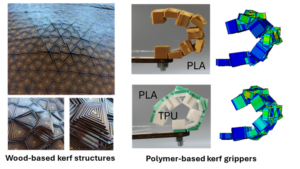

Nonlinear deformation of materials and structures
Soft materials like rubbers and silicone are suitable for lightweight compliant systems which make them appealing for soft robots, artificial organs, and energy absorbers. We are developing nonlinear constitutive material models for various soft materials including light-activated shape memory polymers and simulating the performance of structures or devices out of soft materials.
Through simulations, we have designed pneumatic actuator microdevices for drug release and insect manipulation. By controlling the geometrical parameters of the devices, elasticity of the materials, and amount of pressure, we can precisely control the motions.
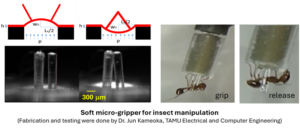
Large deformations can alter the symmetry group of the macromolecular networks of the polymers. We have studied the deformation-induced anisotropy of light-activated shape memory polymers, accounting for the directional preference of the viscoelastic polymer network due to stretching the polymers. The deformation-induced anisotropic behavior leads to different stress concentration patterns when the polymer is exposed to multiple loading histories.
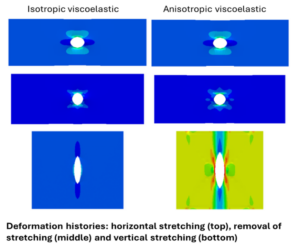
Plant biomechanics
Our interest in plant biomechanics is driven by our curiosity to understand the multi-scale nature of stem failure (lodging) in cereal crops. While this effort focuses on scientific exploration, it has practical relevance with significant societal impacts on food production. The frequency of lodging in crops has increased due to ongoing climate change, i.e., extreme wind, heat, and rain, which poses a major challenge to food production and economic losses. We are collaborating with faculty and researchers from Soil and Crop Science at Texas A&M University (Drs. Scott Finlayson and Bill Rooney) to investigate stem lodging and its translation to breeding lodging-resistant crops.
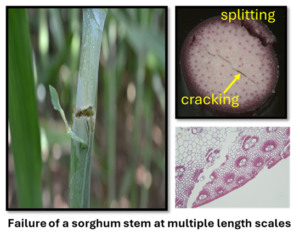
Plants are composites that have remarkable abilities to adapt to different growth conditions. The consequences of plant acclimation can be tracked in the formation and patterns of the tissues, associated with cell wall shapes, sizes, arrangements, and material compositions. For example, periodic bending of stems resulted in thicker cell walls, more fiber bundles, slightly larger diameter, and shorter stature, which affected their lodging responses.

Thermal stresses and warpage in polymers and composites
Structures can experience non-uniform stresses when exposed to changes in the thermal environment, leading to shape distortion or warpage. The non-uniform stresses can be attributed to thermal gradients in the structures and/or from material heterogeneities. We have studied two phenomena of thermal stresses, which are (1) thermal stresses in composite microstructures from exposures to varying temperatures and their effects on composite performances and (2) warpage caused by temporal and spatial phase transformation during material processing.
We have modeled the FDM printing process, incorporating heat transfer and polymer phase transformation, to describe the influence of various printing parameters (i.e., nozzle temperature, diameter and speed, bed and ambient temperatures, raster directions, etc.) on the deformations of printed objects. High thermal stress gradients during printing result in layer separations, which can be mitigated by controlling ambient temperatures (i.e., cooling results in smooth printing or a thin-walled cube).
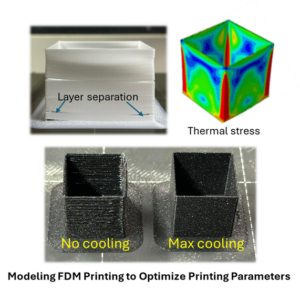
Energy Management in Materials and Structures
In collaboration with Dr. Marcia Coopet at TAMU, we are exploring various designs of reconfigurable structures for energy management under dynamics loadings. We explore the use of irregular granulated materials, which have high energy dissipation ability attributed to particle rearrangements, contact sliding, and/or packing, in manipulating shock propagation in solid structures. HDPE particles subjected to an impact velocity of ~4000 in/sec (100 m/sec) show a significant reduction in the kinetic energy from the contact friction, inelastic material response, and particle reconfiguration from the deformation-induced filling of interstitials.
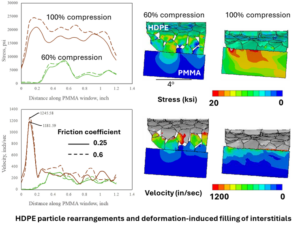
We study the interplay between geometrical parameters and mechanical properties of materials on wave propagations in 3D kerf structures under high strain rates. Kerf structures are easily reconfigured from one freeform shape to other freeform shapes, which can be used in mission-critical applications. For example, the 3D kerf panels can be used as energy dissipation pads during airdrop of supplies and equipment, and later reconfigured to be used for protective shelters or wheelers to transport supplies. A combination of structural reconfiguration and dissipative material in 3D kerf structures enables the controlling of transmitted and reflected waves.
Multifunctional Reconfigurable Composites
Active materials, such as shape memory and electro-active materials, can be integrated into structures for generating reconfigurable systems. Many active materials exhibit nonlinear and time-dependent field coupling behaviors, such as polarization switching in piezoelectric materials, which can influence shape reconfigurations. We study several designs and motion control methods for adaptive electro-active truss structures for potential application in morphing structures and robotic arms. We highlight the influence of actuation rate and frequency on the reconfigurable shapes and hysteretic responses of adaptive truss systems.
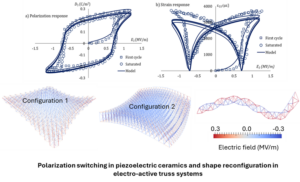
We have explored shape-shifting in thin electro-active bilayers, particularly on understanding the influence of geometrical parameters, nonlinear electro-mechanical responses, and structural instability on shape reconfigurations. A snap-through behavior to form a rolling shape from a dome shape is observed in a bilayer circular membrane to maintain a stable shape with zero (or nearly zero) Gaussian curvature.
